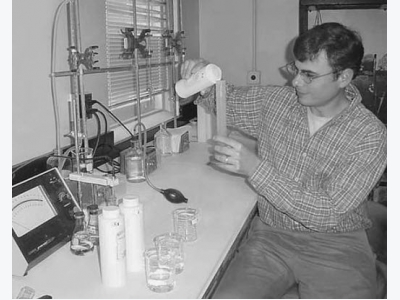Anion-Cation Balance: Cross-Check for Reliability of Ion Analyses

Testing ion balance can help ensure suitable aquaculture conditions for shrimp and other species.
The ionic composition of inland well water can vary from suitable to toxic to cultured animals. Reliable data on concentrations of major cations (calcium, magnesium, potassium, and sodium) and major anions (bicarbonate, sulfate, and chloride) is therefore important in the management of waters for inland shrimp farming.
Cation concentrations usually are determined by atomic absorption spectroscopy (AAmethod) or inductively coupled plasma emission spectroscopy (ICP method). Bicarbonate concentration can be calculated from total alkalinity concentration, which is determined by titration with standard acid. Sulfate concentration can be determined by the barium chloride turbidity method, and chloride can be measured by titration with standard mercuric nitrate.
In AAand ICPanalyses of saline waters, dissolved salts can cause significant interference, so it is always a good idea to check analyses for reliability
Anion-Cation Balance
One useful method for determining the reliability of major ion analyses of freshwater or saline water is measurement of anion-cation balance. This method assumes that major ions comprise most of the total dissolved solids in a water sample, and requires that all major ion concentrations are measured.
The principle of electrical neutrality requires that the equivalent weight of positively charged ions (cations) equal that of the negatively charged ions (anions). Because major ions usually represent most of the dissolved ions in water, equivalent amounts of major cations and anions are typically found. In an accurate analysis, the sum of the milliequivalents of major cations and anions should be nearly equal.
Milliequivalents
The milliequivalent of an ion is determined by dividing its concentration in mg/l by its milliequivalent weight in mg/milliequivalent. Milliequivalent weights for major ions are listed in Table 1.
Table 1. Milliequivalent weights of major ions.
| Anions | Cations | ||
| Bicarbonate | 61 mg/meq | Calcium | 20.04 mg/meq |
| Sulfate | 48 mg/meq | Magnesium | 12.16 mg/meq |
| Chloride | 35.45 mg/meq | Potassium | 39.1 mg/meq |
| Sodium | 23 mg/meq | ||
Balance Calculation
The anion-cation balance calculation can be illustrated with data on the average concentrations of ions in water from a saline aquifer in Alabama, USAas follows: calcium, 86 mg/l; magnesium, 21 mg/l; potassium, 7.7 mg/l; sodium, 1,392 mg/l; sulfate, 2.0 mg/l; chloride, 2,274 mg/l; total alkalinity, 105 mg/l.
First, convert total alkalinity to bicarbonate by the following equation:
Bicarbonate (mg/l) = Total Alkalinity in mg/l as CaCO3 x 1.22
Bicarbonate (mg/l) = 105 x 1.22 = 128 mg/l
The balance calculations are shown in Table 2. Close agreement between the milliequivalents of anions and cations indicates the concentrations of major ions in the sample were analyzed accurately.
Another Example
Consider another example from a recently published paper on inland shrimp farming. The concentrations of major ions were reported as follows: calcium, 250 mg/l; magnesium, 22 mg/l; potassium, 14 mg/l; sodium, 820 mg/l; bicarbonate, 248 mg/l; sulfate, 690 mg/l; chloride, 985 mg/l. The anion-cation balance calculation (Table 3) reveals a greater difference between total anions and total cations than the first example. The average difference in milliequivalents of anions and cations can be estimated as follows:

If the average difference exceeds 15%, one should have serious reservations about the accuracy of the analysis
Checking Accuracy
Another way of checking the accuracy of ion analyses is to determine if the sum of major ions is roughly equal to total dissolved solids. This procedure is suitable in freshwater or waters with 1-2 ppt salinity. However, at greater salinities, water of hydration is retained by the salt residue resulting from evaporation of the sample for total dissolved solids analysis. This leads to erroneously high values for total dissolved solids in saline water samples.
Table 2. Anion-cation balance example.
| Anions | Cations |
| Bicarbonate: 128 mg/l ÷ 61 meq/mg = 2.10 meq/l | Calcium: 86 mg/l ÷ 20.04 mg/meq = 4.29 meq/l |
| Sulfate: 2.0 mg/l ÷ 48 meq/mg = 0.04 meq/l | Magnesium: 21 mg/l ÷ 12.16 mg/meq = 1.73 meq/l |
| Chloride: 2,274 mg/l ÷ 35.45 meq/mg = 64.15 meq/l | Potassium: 7.7 mg/l ÷ 39.1 mg/meq = 0.20 meq/l |
| Sodium: 1,392 mg/l ÷ 23 mg/meq = 60.52 meq/l | |
| Total = 66.29 meq/l | Total = 66.74 |
Table 3. Anion-cation balance example.
| Anions | Cations |
| Bicarbonate: 248 mg/l ÷ 61 meq/mg = 4.07 meq/l | Calcium: 250 mg/ ÷ 20.04 mg/meq = 12.48 meq/l |
| Sulfate: 690 mg/l ÷ 48 meq/mg = 14.38 meq/l | Magnesium: 22 mg/l ÷ 12.16 mg/meq = 1.81 meq/l |
| Chloride: 985 mg/l ÷ 35.45 meq/mg = 27.79 meq/l | Potassium: 14 mg/l ÷ 39.1 mg/meq = 0.36 meq/l |
| Sodium: 820 mg/l ÷ 23 mg/meq = 35.65 meq/l | |
| Total = 46.24 meq/l | Total = 50.30 |
Conclusion
Reliable data on major cation and anion concentrations in waters is an important consideration for inland shrimp farming. The anion-cation balance method presented here to determine the reliability of major ion analyses of fresh- or saline water assumes that major ions comprise most of the total dissolved solids in a water sample, and requires that all major ion concentrations be measured.
If the average difference exceeds 15%, one should have serious reservations about accuracy.
Related news
 Phytoplankton in aquaculture ponds: Friend or foe?
Phytoplankton in aquaculture ponds: Friend or foe? Phytoplankton can be a dilemma in aquaculture. Properly managed populations can be very beneficial (“friend”) to aquaculture production systems
 Decomposition and accumulation of organic matter in ponds
Decomposition and accumulation of organic matter in ponds The major sources of organic matter in aquaculture ponds are organic fertilizer, remains of microorganisms — phytoplankton, zooplankton, and benthos — produced
 Phytoplankton a crucial component of aquaculture pond ecosystems
Phytoplankton a crucial component of aquaculture pond ecosystems Ponds typically contain an abundance of phytoplankton. These organisms play an important role in pond ecology and influence water quality